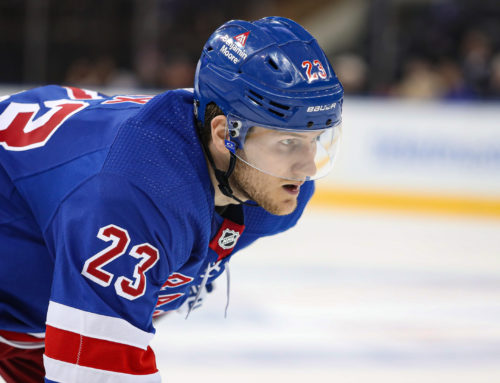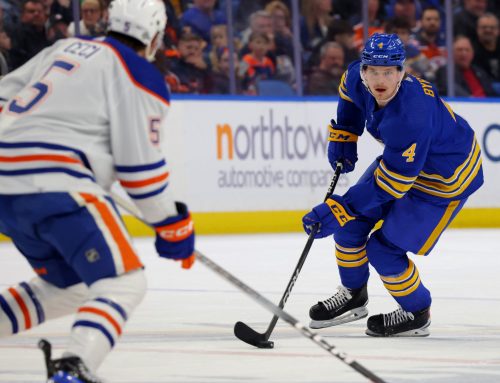
A significant trade took place the day before Free Agent Frenzy, though not to the level of Subban-Weber or Hall-Larsson.
Jason Botterill continues to re-tool the Buffalo blue line, as the Sabres GM traded away Marcus Foligno, Tyler Ennis, and a third-round pick in 2018 to Minnesota for Marco Scandella, Jason Pominville, and a fourth-round pick in 2018.
There was no salary retained anywhere.
A trade that looks fairly large comes down to this: the Wild wanted to shed salary – Pominville and Scandella carry a combined AAV of $9.6 million each of the next two seasons – and Buffalo wanted to add pieces. Foligno is an RFA, and Ennis has two years left at $4.6 million each season.
I want to focus on Scandella quickly.
From 2013-2016, these four defencemen all tied in points per 60 minutes at five-on-five, and all played over 3000 minutes (via Hockey Analysis):

That is pretty good company for the newest Sabre.
Admittedly, he did falter a bit in this regard last season at 0.59 points per 60. However, his primary points/60 from 2013-16 was 0.5, and that was 0.42 this past season. The majority of the drop-off, then, was from a lack of secondary assists, which we know can be very random.
Scandella, though probably not a top-pairing guy, is a capable second-pairing player and has shown in previous seasons the ability to produce at a level commensurate with other productive blue liners when given the opportunity. Though he won’t be taking over the top power-play unit I don’t think, this is another addition that may eat into the total minutes of Rasmus Ristolainen.
****
Throughout the summer, I’ll be going over each team one by one to review the fantasy performances of some individual players. Next on the list in alphabetical order is the Florida Panthers.
I left this team to Canada Day if only because of what an about-face this year will be to the last. The 2016 offseason saw the team add Keith Yandle, extend Aaron Ekblad, Vincent Trocheck, and Reilly Smith, and sign Jon Marchessault, James Reimer, and Jason Demers. For the 2017 offseason, Frank Seravalli of TSN was reporting on television Friday morning that their mandate this year was to cut salary. The roster in 2017-18 could look significantly different from 2016-17.
Like the Dallas Stars, it’s important to keep in mind that this team suffered injuries to key players, some of them significant: Jonathan Huberdeau missed 51 games, Nick Bjugstad was out for 28, Aleksander Barkov was out of the lineup for 21 games, while Aaron Ekblad missed 14. When your top line left winger is out over half the year, your top centre misses a quarter of the season, and your top young defenceman is out for double-digit games, it’s going to have a significant negative effect on your team.
With that caveat given, this is what their players achieved in 2016-17 from a fantasy slant.
Thanks to the injuries down the middle, Trocheck was asked to play a lot of minutes, finishing fourth in the league for total ice time among all forwards, behind only Patrick Kane, Ryan Kesler, and Connor McDavid.
All that ice time helped him to 23 goals and 54 points, which is a solid season. It’s hard to wonder what would have been, however, had the team not shot under 7 percent with him on the ice (which was below the league average, but above his team’s average). In fact, among all the seasons of forwards with at least 1650 minutes played in a single year over the last four campaigns, Trocheck had the second-lowest point total, and compared best to Ryan Kesler. That is very inefficient.
On the bright side here, there are two takeaways:
- Marchessault being sent to Las Vegas means that there is an opening for a right shot on the top power-play unit. This would seem to open the door for Trocheck to consistently see top man advantage minutes.
- He shot a lot more per minute at five-on-five than the year before. It’s not a function of new line mates, either, and he mostly played with Jussi Jokinen and Reilly Smith both seasons. The step forward in this area should help him be at, or above, 20 goals again.
The ice time may come down in 2017-18, but an increased shooting percentage for the team should help offset that. Combined with (hopefully) getting top power-play time, and Trocheck should have a 50-point floor.
Despite being very productive early in his career, we need to discuss the injuries Barkov has suffered to date. In 2013-14, it was a knee injury; 2014-15 was a broken hand; 2015-16 was a wrist injury; 2016-17 was an upper-body injury (did we ever find out what that was? Let me know in the comments). All told, out of 328 games, Barkov has missed 76, or an average of 19 per campaign. That is a lot of time missed over a four-year span. Even working with the assumption of poor luck, it’s hard to project him for more than 72 games for next year. That is important to keep in mind.
As mentioned, he has been very productive, especially over the last three years – since the start of the 2014 campaign, he’s tied for 32nd in points per 60 minutes at five-on-five (2.04) out of 261 forwards with at least 2000 minutes played. He was higher than that in 2016-17 at 2.19. It’s pretty clear he and Jonathan Huberdeau have good chemistry, as their shooting percentage together and away from each other over the last three years are very stark in contrast (via Puckalytics):

It is fair to wonder what the effect of Jaromir Jagr has here, and we may find out next season should he not be brought back. That is for another time, however.
Unlike Trocheck, there was not a progression in shooting rate. In fact, he declined from 2015-16 to last year. Injuries were perhaps part of it, but considering he’s been injured every year, I’m not sure this can be used an excuse.
Not shooting a lot isn’t an issue in and of itself. There are a lot of productive players in his range from the last three years like Evgeny Kuznetsov, Johnny Gaudreau, and TJ Oshie. One thing it does, however, is kill his value in roto leagues (even if he plays 82 games, 200 shots would be an achievement). And it also limits his upside, because unless his shooting percentage takes a huge deviation upwards, getting to 30 goals will be a stretch. He would have to shoot at least 15 percent (which is above his career average) and manage 200 shots on goal (which he’d need a full season to get to) to get to that coveted goal-scoring mark.
It felt like a down year for the Panthers blue liner, didn’t it? He still managed 41 points, his seventh consecutive 82-game season with at least 40 points.
One thing that didn’t happen last year for Yandle was a big rebound in shot attempts. He averaged at least 13 per 60 minutes of five-on-five in his final four years in Arizona, and that has fallen below 11 each of the last two years. I had hoped that his year in New York was just a blip, but it appears to be the start of a trend.
It’s pretty important to note that Yandle is playing the distributor role rather than a shooting role he was earlier in his career because last year was the fourth straight year he’s shot under four percent. Among players with 300 games played and 600 shots on goal in that span, he’s last in shooting percentage, and it’s not close:
The other problem stemming from last year was the top power-play unit. Yandle still managed 18 power-play points, which helped his fantasy value a lot. Looking ahead, a healthy Ekblad could cut into those minutes should they decide to go with a 4-1 power-play setup again, with the top unit loaded. It depends which they use, and Yandle did get more PP ice time per game last year. It’s a matter of time before the keys are handed over, it appears.
Next year should be more of the same from Yandle, and a rebound in scoring from the team will mean good things. My only concern is some of the peripherals are taking a nosedive, and a decline in power-play production will only compound the problem.
****
Washington locked up a core piece of their blue line on Friday, but not the one most people have been talking about of late:
Caps have re-signed defenseman Dmitry Orlov to a six-year deal. $5.1 million AAV.
— Isabelle Khurshudyan (@ikhurshudyan) June 30, 2017
There was also this little nugget that Ms. Khurshudyan tweeted out later:
Think this is good deal for both. More than what Zaitsev got for 7 years. Less than Leddy's deal with the Isles, which I heard was a comp.
— Isabelle Khurshudyan (@ikhurshudyan) June 30, 2017
That comp is a little interesting for a couple reasons. First, Nick Leddy signed the deal two years ago when the cap was $4.5 million less than it is now. A $5.5 million AAV two years ago would be roughly $5.8 million now (if my math is right). Also, Leddy got seven years instead of six. However, there are a lot of defencemen in that age range that only got four-year deals (Tyson Barrie, Torey Krug, and Sami Vatanen, for example). Despite the discrepancies, Leddy seems to be one of the more accurate comparisons to make.
Implications in cap leagues here are interesting. Orlov seems to be the heir-apparent to the top power-play unit, and John Carlson only has one year left on his contract. On the other hand, Orlov is a left shot, which makes it harder to set up Alex Ovechkin for his one-timers. They may just use Matt Niskanen on the top unit instead.
Is Carlson a Washington Capital in 13 months? That is kind of the gamble Orlov’s fantasy owners have to take here. If Carlson is extended, Orlov is probably not worth his value in cap leagues. If Carlson is not extended, Orlov could be a bargain. It would make sense that Carlson returns to the fold, but the team has $50 million locked up in just nine players after 2017-18. They might not be able to afford him.
What say you, fantasy hockey heads? Is Orlov worth acquiring for the long-term in cap leagues or is the gamble too big right now?





 FLA
FLA CHI
CHI NYR
NYR PIT
PIT L.A
L.A COL
COL CBJ
CBJ TOR
TOR MTL
MTL ANA
ANA
 PHI
PHI VAN
VAN ARI
ARI
